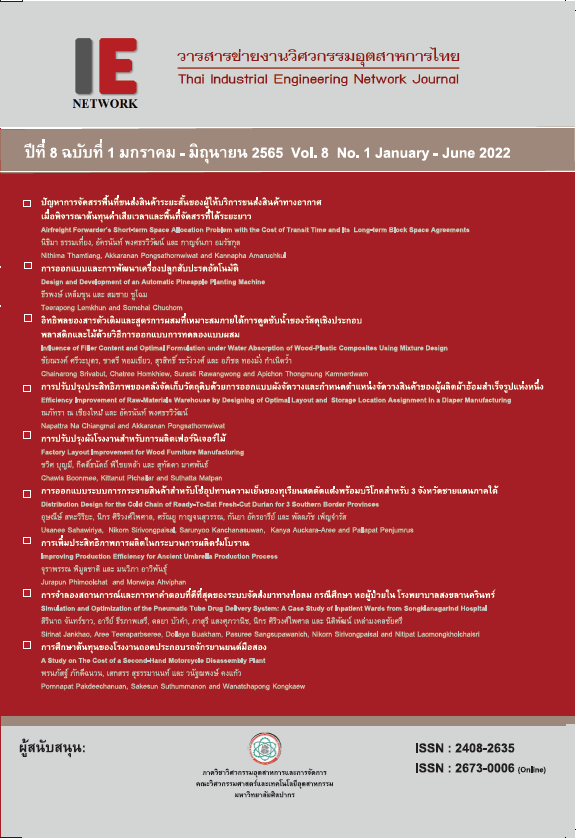Influence of Filler Content and Optimal Formulation under Water Absorption of Wood-Plastic Composites Using Mixture Design
Main Article Content
Abstract
The prediction of optimal proportion of wood-plastic composites (WPCs) under water absorption for 2h and 24h was investigated. The experimental design was determined from mixture design. Factors of experiment were recycled high-density polyethylene (rHDPE), rubberwood sawdust (RWS), and carbon black (CB) with constant of coupling agent (MAPE) and lubricant (WAX), respectively. The experimental results were analyzed by analysis of variance (ANONA) and optimized using response surface methodology (RSM). The results of the experiment showed that the mixture ratios had significantly (P < 0.05) affected on short-term water absorption. Increasing of rubberwood sawdust resulted in increased water absorption properties. In contrast, the Increasing of recycled high-density polyethylene and carbon black resulted in decreased water absorption properties. Additionally, the regression model and contour plot were used to analysis the effects of factors mixture ratios. The optimal proportion of WPCs was 55.0wt% rHDPE, 25.0wt% RWS, 15.0wt% CB, 4.0wt% MAPE, and 1.0wt% WAX with desirability score combining their outputs value of 97.10%. To the accuracy of the response prediction, the optimal proportion was observed in the actual value to compare the experimental results and determine the percentage error of the experiment.
Article Details

This work is licensed under a Creative Commons Attribution-NonCommercial-NoDerivatives 4.0 International License.
บทความ ข้อมูล เนื้อหา รูปภาพ ฯลฯ ที่ได้รับการตีพิมพ์ในวารสารฯ ถือเป็นลิขสิทธิ์ของวารสารฯ หากบุคคลหรือหน่วยงานใดต้องการนำทั้งหมดหรือส่วนหนึ่งส่วนใดไปเผยแพร่ต่อหรือเพื่อกระทำการใดๆ จะได้รับอนุญาต แต่ห้ามนำไปใช้เพื่่อประโยชน์ทางธุรกิจ และห้ามดัดแปลง
References
T. Ratanawilai, P. Lekanukit, and S. Urapantamas, “Effect of rubberwood and palm oil content on the properties of wood–polyvinyl chloride composites”, Journal of Thermoplastic Composites Material, Vol 27, pp. 719-730, 2014.
C. Srivabut, T. Ratanawilai, and S. Hiziroglie, “Statistical modeling and response surface optimization on natural weathering of wood-plastic composites with calcium carbonate filler”, Journal of Material Cycles and Waste Management, vol 23, pp. 1503-1517, 2021.
N. Ayrilmis, U. Buyuksari, and T. Dundar, “Waste pine cones as a source of reinforcing fillers for thermoplastic composites”, Journal of Applied Polymer Science, Vol. 117, pp. 2324-2330, 2010.
A. Zolfaghari, A. H. Behravesh, and P. Shahi, “Comparison of mechanical properties of wood–plastic composites reinforced with continuous and noncontinuous glass fibers”, Journal of Thermoplastic Composites Material, vol 28, pp. 791-805, 2015.
Z. H. Xu and Z. N. Kong, “Mechanical and thermal properties of short-coir-fiberreinforced natural rubber/polyethylene composites, Mechanics”. Composite Materials, vol. 50, pp. 353-358, 2014.
E.O. Olakanmi, E.A. Ogunesan, E. Vunain, R.A. Lafia-Araga, M. Doyoyo, and R. Meijboom, “Mechanism of Fiber/Matrix Bond and Properties of Wood Polymer Composites Produced From Alkaline-Treated Daniella oliveri Wood Flour”, Journal of Polymer Composites, vol. 37, pp. 2657-2672, 2016.
T. Ratanawilai, and K. Taneerat, “Alternative polymeric matrices for wood-plastic composites: Effects on mechanical properties and resistance to natural weathering”. Construction and Building Materials, vol. 172, pp. 349-357, 2018.
J. Lamaming, R. Hashim, O. Sulaiman, T. Sugimoto, M. Sato, and S. Hiziroglu, “Measurement of some properties of binderless particleboards made from young and old oil palm trunks”, Measurement, vol 47, pp. 813–819, 2014.
S. Khamtree, T. Ratanawilai, and S. Ratanawilai, “The effect of alkaline-silane treatment of rubberwood flour for water absorption and mechanical properties of plastic composites” Journal of Thermoplastic Composites Material, vol. 33, pp. 599 - 613, 2020.
H. Essabir, R. Boujmal, M.O. Bensalah, D. Rodrigue, R. Bouhfid, and A.E. Qaiss, “Mechanical and thermal properties of hybrid composites: Oil-palm fiber/clay reinforced high density polyethylene”, Mechanics of Materials, vol. 98, pp. 36-43, 2016.
R.Z. Huang, B.J. Kim, S. Lee, Z. Yang, and Q.L. Wu, “Co-extruded wood-plastic composites with talc-filled shells: morphology, mechanical, and thermal expansion performance”, BioResources, vol. 8, pp. 2283-2299, 2013.
B. Kord, A. Varshoei, and V. Chamany, “Influence of chemical foaming agent on the physical, mechanical, and morphological properties of HDPE/wood flour/nanoclay composites”, Journal of Reinforced Plastics and Composites, vol. 30, pp. 1115-1124, 2011.
C. Srivabut, T. Ratanawilai, and S. Hiziroglie, “Response surface optimization and statistical analysis of composites made from calcium carbonate filler-added recycled polypropylene and rubberwood fiber” Journal of Thermoplastic Composites Material, 2019, DOI10.1177/0892705719889988.
C. Homkhiew, T. Ratanawilai, and W. Thongruang, The optimal formulation of recycled polypropylene/rubberwood flour composites from experiments with mixture design, Composites Part B-Engineering, vol. 56, pp. 350-357, 2014.
C. Homkhiew, and T. Ratanawilai, Optimal Proportions of Composites from Polypropylene and Rubberwood Flour after Water Immersion Using Experimental Design, KKU Research Journal, 19, 780-793, 2014. (in Thai)
S. Khamtree, T. Ratanawilaia, S. Ratanawilaib, Determining the optimum conditions for silane treated rubberwood flourrecycled polypropylene composites using response surface methodology, Materals Today Communication, vol. 24, 100971, 2020.
P. Y. Kuo, S. Y. Wang, J. H. Chen, H. C. Hsueh, and M. J. Tsai, “Effects of material compositions on the mechanical properties of wood–plastic composites manufactured by injection molding”, Material & Design, vol. 30, pp. 3489-3496, 2014.
S. Butylina, M. Hyvärinen, and T. Kärki, “A study of surface changes of wood-polypropylene composites as the result of exterior weathering”, Polymer Degradation and Stability, vol. 97, pp. 337-345, 2012.


